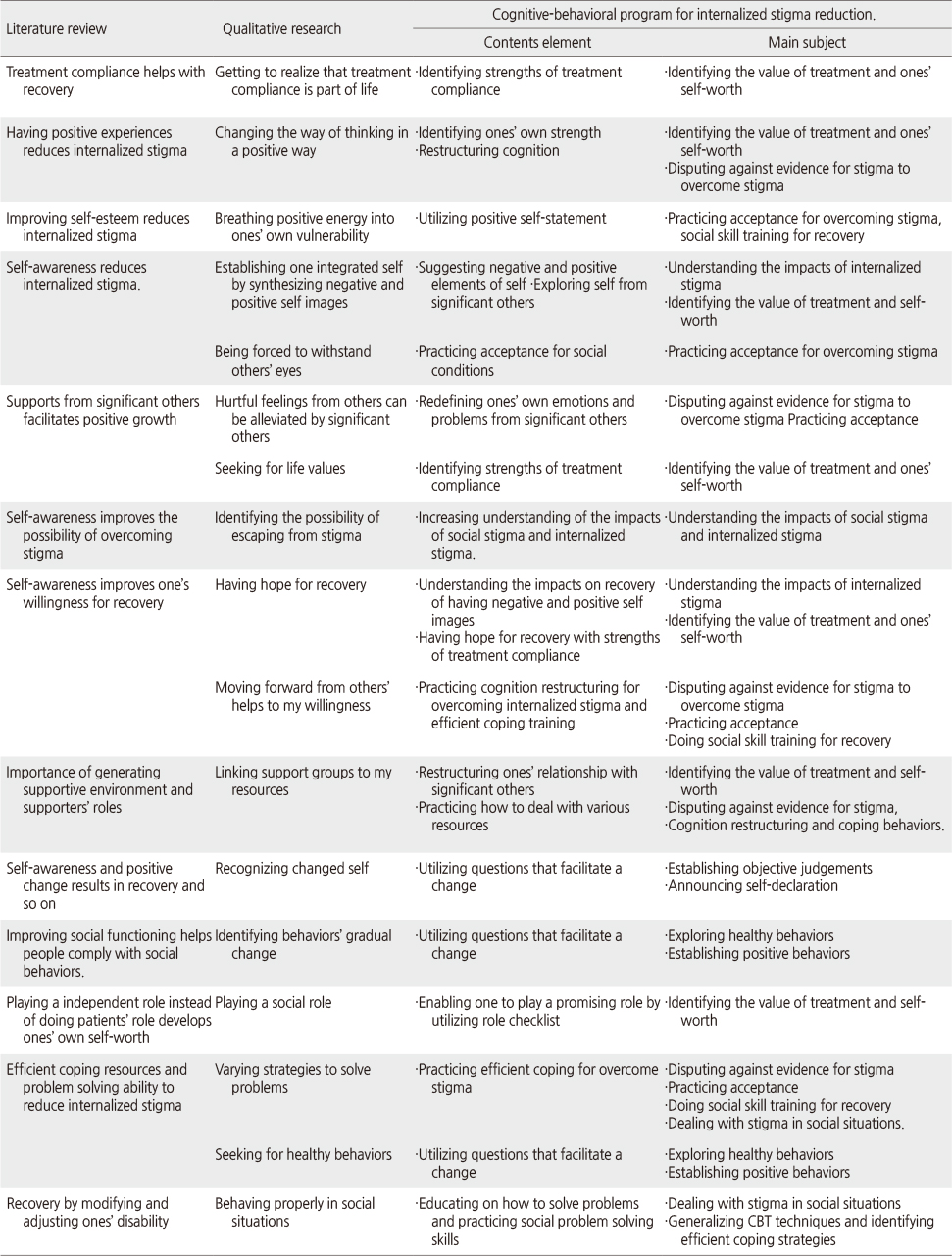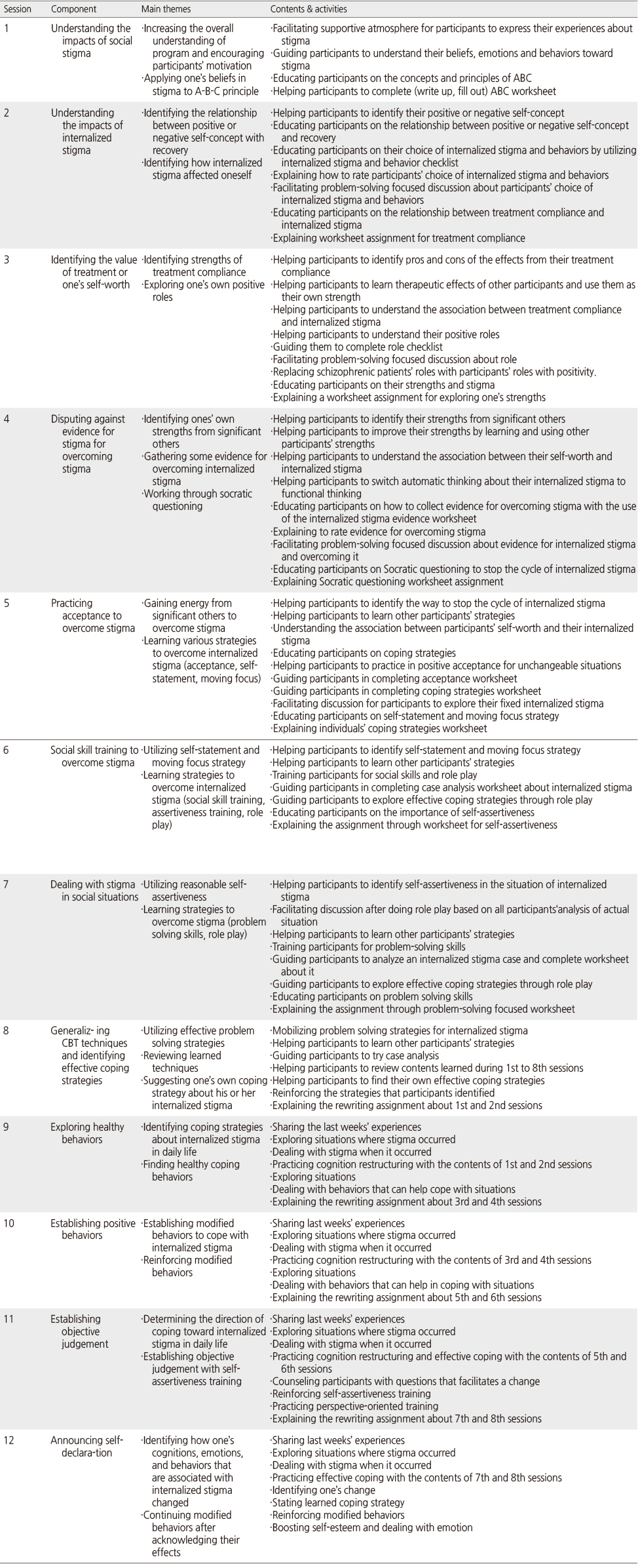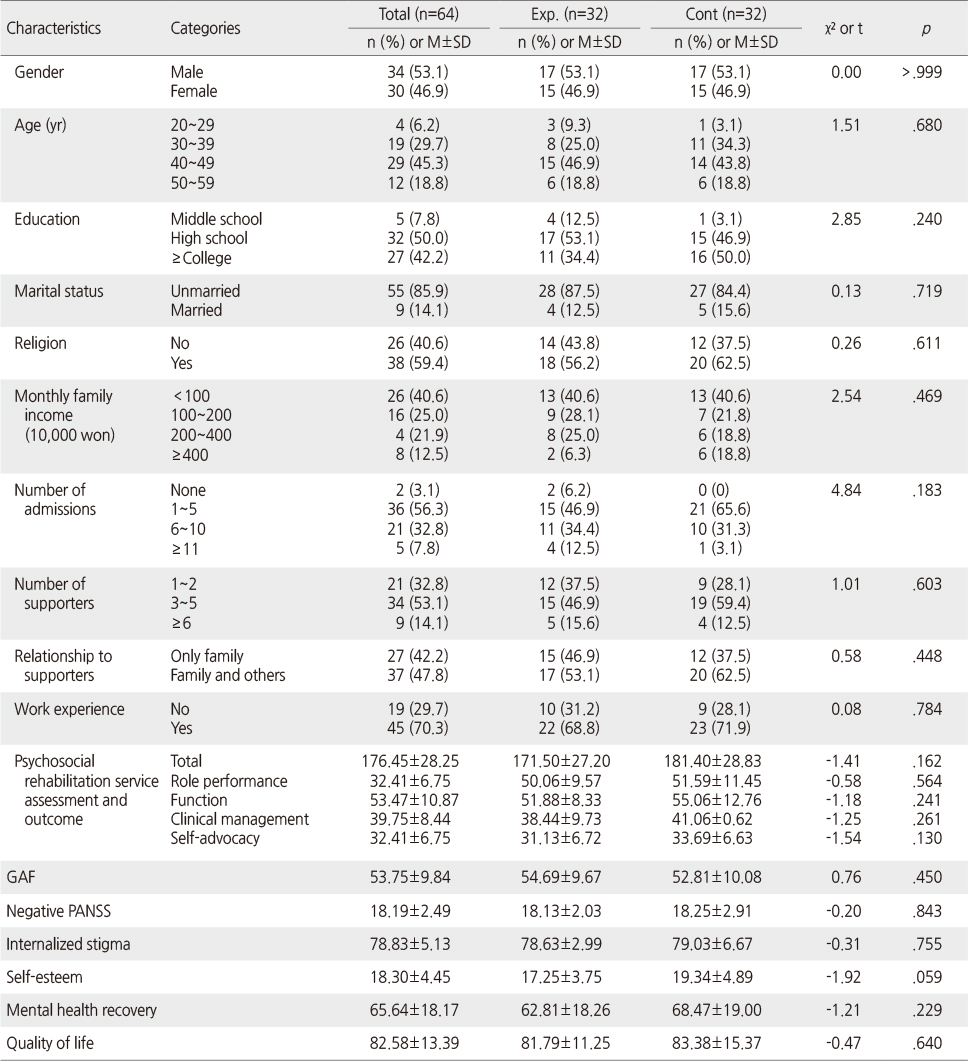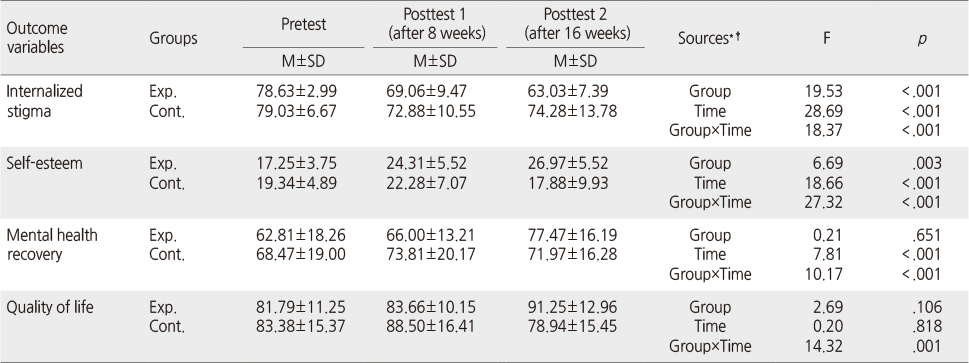Articles
- Page Path
- HOME > J Korean Acad Nurs > Volume 46(3); 2016 > Article
-
Original Article
- Development and Effects of a Cognitive-behavioral Therapy Based Program in Reducing Internalized Stigma in Patients with Schizophrenia
- Mi Young Kim, Seong Sook Jun
-
Journal of Korean Academy of Nursing 2016;46(3):349-363.
DOI: https://doi.org/10.4040/jkan.2016.46.3.349
Published online: June 30, 2016
1Department of Nursing, Kaya University, Gimhae, Korea.
2College of Nursing, Pusan National University, Yangsan, Korea.
- Address reprint requests to: Jun, Seong Sook. College of Nursing, Pusan National University, 49 Busandaehak-ro, Mulgeum-eup, Yangsan 50612, Korea. Tel: +82-51-510-8359, Fax: +82-51-510-8308, jss@pusan.ac.kr
© 2016 Korean Society of Nursing Science
This is an Open Access article distributed under the terms of the Creative Commons Attribution NoDerivs License. (http://creativecommons.org/licenses/by-nd/4.0/) If the original work is properly cited and retained without any modification or reproduction, it can be used and re-distributed in any format and medium.
Abstract
-
Purpose
- This study was done to develop a internalized stigma reducing program based on cognitive-behavioral therapy and appropriate for patients with schizophrenia and to evaluate its effectiveness.
-
Methods
- The study design was a mixed method research. Qualitative study, 13 patients with schizophrenia who had experience in overcoming stigma were purposively chosen for interviews and data were analyzed using Giorgi method. Quantitative study, 64 patients with schizophrenia (experimental group=32, control group=32) were recruited. The cognitive-behavioral therapy-based program for reducing internalized stigma in patients with schizophrenia was provided for 8 weeks (12 sessions). Data were collected from June. 20, 2013 to Feb. 14, 2014. Quantitative data were analyzed using χ2-test, t-test, repeated measures ANOVA with the SPSS program.
-
Results
- Qualitative results, from the experience of coping with stigma in patients with schizophrenia seventeen themes and five themes-clusters were drawn up. Quantitative results showed that internalized stigma, self-esteem, mental health recovery and quality of life were significantly better in the experimental group compared to the control group.
-
Conclusion
- Study findings indicate that this program for reducing internalized stigma in patients with schizophrenia is effective and can be recommended as a rehabilitation program intervention to help patients with schizophrenia to cope with internalized stigma.
This manuscript is based on a part of the first author's doctoral dissertation from Pusan National University.
The authors declared no conflict of interest
- 1. Kim SW, Yoon JS, Lee MS, Lee HY. The analysis of newspaperarticles on psychosis. J Korean Neuropsychiatr Assoc. 2000;39(5):838–848.
- 2. Crisp AH, Gelder MG, Rix S, Meltzer HI, Rowlands OJ. Stigmatisation of people with mental illnesses . Br J Psychiatry. 2000;177:4–7. ArticlePubMed
- 3. Corrigan PW, Watson AC. The paradox of self-stigma and mental illness. Clin Psychol. 2002;9(1):35–53. Article
- 4. Rüsch N, Corrigan PW, Wassel A, Michaels P, Olschewski M, Wilkniss S, et al. A stress-coping model of mental illness stigma: I. Predictorsof cognitive stress appraisal. Schizophr Res. 2009;110(1-3):59–64. ArticlePubMedPMC
- 5. Fung KM, Tsang HW, Cheung WM. Randomized controlled trial of the self-stigma reduction program among individuals with schizophrenia. Psychiatry Res. 2011;189(2):208–214. ArticlePubMed
- 6. Knight MTD, Wykes T, Hayward P. Group treatment of perceived stigma and self-esteem in schizophrenia: A waiting list trial of efficacy. Behav Cogn Psychoth. 2006;34(3):305–318. Article
- 7. Yanos PT, Roe D, West ML, Smith SM, Lysaker PH. Group-based treatment for internalized stigma among persons with severe mental illness: Findings from a randomized controlled trial. Psychol Serv. 2012;9(3):248–258. ArticlePubMedPMC
- 8. WHO Collaborating Center for Psychosocial Rehabilitation and Community Mental Health. Patient empowerment programme for schizophrenia. 3rd ed. Yongin: Yongin Mental Hospital WHO Collaborating Center for Psychosocial Rehabilitation and Community Mental Health; 2012. p. 136.
- 9. Lee WK, Hwang TY. Efficacy of a group treatment, self-stigma overcome programs for inpatients with schizophrenia. J Korean Neuropsychiatr Assoc. 2010;49(5):444–452.
- 10. Ko KH, Yang SH, Kim YA, Kwon MS, Bang SH, Lee JM, et al. The effects of an empowerment program for chronic schizophrenic patients on their empowerment and internalized stigma. J Korean Acad Psychiatr Ment Health Nurs. 2008;17(4):491–499.
- 11. Brohan E, Elgie R, Sartorius N, Thornicroft G. Self-stigma, empowerment and perceived discrimination among people with schizophrenia in 14 European countries: The GAMIAN-Europe study. Schizophr Res. 2010;122(1-3):232–238. ArticlePubMed
- 12. Dickerson FB, Tenhula WN, Green-Paden LD. The token economy for schizophrenia: Review of the literature and recommendations for future research. Schizophr Res. 2005;75(2-3):405–416. ArticlePubMed
- 13. Kurtz MM, Mueser KT. A meta-analysis of controlled research on social skills training for schizophrenia. J Consult Clin Psychol. 2008;76(3):491–504. ArticlePubMed
- 14. Fotoukian Z, Shahboulaghi FM, Khoshknab MF, Mohammadi E. Concept analysis of empowerment in old people with chronic diseases using a hybrid model. Asian Nurs Res (Korean Soc Nurs Sci). 2014;8(2):118–127. ArticlePubMed
- 15. Park BS, Bae SW. Development of psychosocial rehabilitation service assessment and outcome scale: Focusing on psychosocial rehabilitation model. Ment Health Soc Work. 2013;41(1):114–142.
- 16. Endicott J, Spitzer RL, Fleiss JL, Cohen J. The global assessment scale. A procedure for measuring overall severity of psychiatric disturbance. Arch Gen Psychiat. 1976;33(6):766–771.PubMed
- 17. Yi JS, Chung MH, Lee BW, Lee SI. Reliability and validity of the Korean version of global assessment of functioning scale. Schizophr Clin. 2003;6(2):118–124.
- 18. Kay SR, Fiszbein A, Opler LA. The positive and negative syndrome scale (PANSS) for schizophrenia. Schizophr Bull. 1987;13(2):261–276.ArticlePubMed
- 19. Yi JS, Ahn YM, Shin HK, An SK, Joo YH, Kim SH, et al. Reliability and validity of the Korean version of the positive and negative syndrome scale. J Korean Neuropsychiatr Assoc. 2001;40(6):1090–1105.
- 20. Ritsher JB, Phelan JC. Internalized stigma predicts erosion of morale among psychiatric outpatients. Psychiatry Res. 2004;129(3):257–257.ArticlePubMed
- 21. Hwang TY, Lee WK, Han ES, Kwon EJ. A study on the reliability and validity of the Korean version of internalized stigma of mental illness scale (K-ISMI). J Korean Neuropsychiatr Assoc. 2006;45(5):418–426.
- 22. Rosenberg M. Society and the adolescent self-image. Princeton, NJ: Princeton University Press; 1965. p. 347.
- 23. Jon BJ. Self-esteem: A test of its measurability. Yonsei Nonchong. 1974;11:107–130.
- 24. Bullock WA. The mental health recovery measure. In: Campbell-Orde T, Garrett E, Leff S, editors. Measuring the promise of recovery: A compendium of recovery and recovery related instruments, Part II. Cambridge, MA: The Evaluation Center@HSRI; 2005. p. 36–41.
- 25. Song GO. Validation of the Korean version of the mental health recovery measure. Ment Health Soc Work. 2010;34(4):154–188.
- 26. Min SK, Lee CI, Kim KI, Suh SY, Kim DK. Development of Korean version of WHO quality of life scale abbreviated version (WHOQOL-BREF). J Korean Neuropsychiatr Assoc. 2000;39(3):571–579.
- 27. Giorgi A. The theory, practice, and evaluation of the phenomenological method as a qualitative research procedure. J Phenomenol Psychol. 1997;28(2):235–260. Article
- 28. Lucksted A, Drapalski A, Calmes C, Forbes C, DeForge B, Boyd J. Ending self-stigma: Polit evaluation of a new intervention to reduce internalized stigma among people with mental illnesses. Psychiatr Rehabil J. 2011;35(1):51–54. PubMed
REFERENCES
Figure & Data
REFERENCES
Citations

- Positive mental health interventions for people with schizophrenia: A scoping review
Catarina Nogueira, Emanuel Dias Pereira, Joana Catarina Ferreira Coelho, Antonio Rafael Moreno-Poyato, Carlos Alberto Cruz Sequeira
Schizophrenia Research.2025; 276: 40. CrossRef - Cognitive behavioural therapy for women with infertility: A systematic review and meta‐analysis
Guangpeng Wang, Xueyan Liu, Jun Lei
Clinical Psychology & Psychotherapy.2023; 30(1): 38. CrossRef - Terapia cognitivo conductual y esquizofrenia: un estudio de revisión sobre su eficacia
Jessica Marithza Ortíz Fernández, Esteban Cañizares Abril
Pro Sciences: Revista de Producción, Ciencias e Investigación.2021; 5(41): 362. CrossRef - Effects of Mindfulness-Based Stress Reduction (MBSR) on Stress, Heart Rate Variability, Affect, and Wellbeing among People with Schizophrenia
Ae Sil Kim, Mi Heui Jang, Min Jung Sun
International Journal of Environmental Research and Public Health.2021; 18(22): 11871. CrossRef - Effects of Self-Assertive Training Applying Reality Therapy Techniques on Self-esteem and Internalized Stigma in Schizophrenia Patients
Na-Ra Kim, Mi Heui Jang
Journal of Korean Academy of Psychiatric and Mental Health Nursing.2019; 28(1): 37. CrossRef - Evolutionary Concept Analysis of Resilience in People with Mental Disabilities
Seog-Bun Yoo, Gwi-Ryung Son Hong
Journal of Korean Academy of Psychiatric and Mental Health Nursing.2017; 26(4): 333. CrossRef - Overcoming Internalized Stigma in Persons with Psychiatric Disabilities
Mi Young Kim, Seong Sook Jun, Eun Kyung Byun
Journal of Korean Academy of Psychiatric and Mental Health Nursing.2017; 26(3): 238. CrossRef
Description of Mixed Method Study
Description of Intervention
Homogeneity of General Characteristics and Function (N=64)
Exp.=Experimental group; Cont.=Control group; GAF=Global Assessment of Function; PANSS=Positive and Negative Syndrome Scale.
Changes in Outcome Variables from Baseline to 16-week Follow-up (N=64)
*by one-way repeated measured ANOVA; †by mixed ANOVA; Exp.=Experimental group (n=32); Cont.=Control group (n=32).
Exp.=Experimental group; Cont.=Control group; GAF=Global Assessment of Function; PANSS=Positive and Negative Syndrome Scale.
*by one-way repeated measured ANOVA; †by mixed ANOVA; Exp.=Experimental group (n=32); Cont.=Control group (n=32).
 KSNS
KSNS
 E-SUBMISSION
E-SUBMISSION




 Cite
Cite

